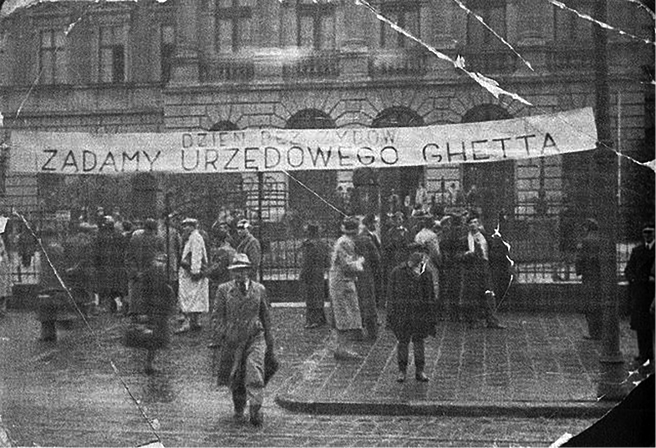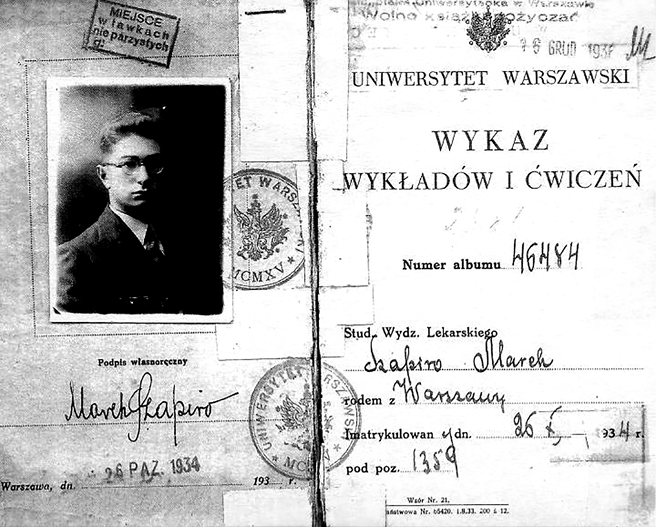6. The first ghetto benches in the universities
Translation © 2024 Brym & Jany, CC BY-NC 4.0 https://doi.org/10.11647/OBP.0342.06
In tsarist Russia, the tsar and his ministers orchestrated anti-Jewish pogroms. Of course, there were antisemitic sentiments among the masses, and there was certainly no shortage of intellectual agitators and instigators. Nevertheless, pogroms had to be organized by representatives of the regime. The passive, unexpressed antisemitic sentiments among the masses were not enough to propel them to go out and beat, pillage, murder, and burn. The surrounding revolutionary atmosphere used to swallow and dissolve these kinds of passive antisemitic sentiments.43
In Hitler’s Germany today, the ministers’ most frenzied agitation and the open calls to pogroms by the highest-level representatives of the government are of no use. The population at large remains indifferent to the pogrom cries. When the government needs a pogrom, it must send its loyal servants from Hitler’s party. Even when these servants drag Jews through the streets and smash windows of Jewish businesses, bystanders of all classes remain calm and indifferent and take no part in this “nationally” sanctified work.
We have an entirely different situation in today’s Poland. The government fights against pogroms—weakly, tentatively, unenergetically, neither actively nor harshly enough. Nonetheless, nobody accuses it of organizing pogroms or aiding the pogromists. The pogrom wave is not imposed from above but rises from below, from the broad masses, the intelligentsia, small-scale proprietors, peasants, and the déclassés.
One can certainly level enough accusations against the governments of the ruling camp in Poland. The fact that they have treated Jews like stepchildren for years, excluding them from state enterprises and state and municipal positions, has inevitably created an impression among the masses that Jews are second-class citizens, or that they are not citizens at all. It is also criminal that for years they allowed the antisemitic press to agitate and incite and blame the Jews for all hardships and misfortunes. However, none of this changes the immensely important and dismal fact that the current pogrom waves have emerged from the broad masses, rising from below and endangering the current government alongside the Jews. One must not shut one’s eyes to reality. There is truth in the words of a high-level official who said that if they wanted to arrest all higher education students who are active antisemites, they would have to imprison thousands of students, and if they wanted to arrest all non-student active antisemites, they would have to imprison tens of thousands of people.
The depth of the tragedy lies in the fact that the pogrom wave is expanding and spreading as a mass movement, like a powerful current driven not by agitators and provocateurs but by the masses. Of course the professional antisemitic provocateurs, who boast that they will soon be able to celebrate the fiftieth anniversary of their “national” work, are taking advantage of the antisemitic mood. Of course these provocateurs are, to a large extent, to blame for this mood of agitated antisemitism. However, it is also true that they have never had such easy successes as in recent years. The influx into the antisemitic parties has far exceeded the leaders’ expectations.
It is also significant to note their activity and their readiness not just to speak, but to do. When one hooligan is arrested, ten more sprout up in his place; when one student is punished, tens more take his place. The more the government steps aside and gives in and keeps quiet and looks away and pretends not to notice, the bigger the pogrom wave swells, the bolder the antisemitic press grows, the bloodier the attacks become, the more numerous the victims, and the more discouraged and dejected the mood among Jews.
At the University of Lemberg, another Jewish victim has fallen: the Jewish student Iserduer was stabbed in the head with a knife. Her condition is critical. Several other Jewish students were beaten and wounded. As is known, the Lemberg Polytechnic instituted a ghetto for Jews more than two months ago: separate benches and separate rooms for laboratory work. The professors promised that this was just temporary. However, the new order was well received, and the student hooligans at the University of Lemberg undertook the adoption of this same reform. Attacks are taking place in nearly all faculties. They drag Jewish students off the benches. Those who resist are beaten and thrown out of the university. Other Jewish students do not sit at all, instead standing throughout the entirety of their lectures.

Fig. 7 Demonstration of Endek students at Lvov Polytechnic. The banner reads: “A Day without Jews: We will create an official ghetto.” Wikimedia, public domain, https://commons.wikimedia.org/wiki/File:%C5%BB%C4%85damy_urz%C4%99dowego_getta_Ob%C3%B3z_Narodowo-Radykalny_Politechnika_Lwowska.jpg
At the veterinary institute in Grokhov {Horokhiv}, the situation is dire. The violence there is being led by two antisemitic heroes who had already stood trial last year for leading assaults against Jews. Attacks took place throughout the entire day in all courses. The student hooligans drove Jews out of the first rows of benches, threw their books and notebooks into the last rows, and did not allow a single Jew to occupy a seat in the front benches. All of the professors were “neutral.”
In the trade school for hairdressers in Lodz, Christian students demanded that the teacher not call Jewish students up to the board. The teacher promised them that he would call up a Jewish student only after ten non-Jews. In another class in that same school, the teacher asked all of the Jewish students to leave the classroom because he wanted to consult with the Christian students. The school’s director promised a Jewish delegation to put an end to these kinds of antisemitic acts.
Unrest erupted at the University of Krakow. The Polish students demanded that their Jewish colleagues sit on separate benches. The Jews refused, and the lectures were cancelled.

Fig. 8 First pages of the “List of Lectures and Exercises” for medical school student Marek Szapiro, University of Warsaw. The stamp above the photo reads, “SEATING in benches with an odd number.” Wikimedia, public domain, https://commons.wikimedia.org/wiki/File:Index_of_Jewish_student_in_Poland_with_Ghetto_benche_seal_1934.PNG
Seven Jewish students were expelled from the Lemberg Polytechnic for signing the protest against the ghetto benches. The eighth, Altfeld, was not expelled because he had been brutally beaten. For that reason, he was forgiven the sin of protesting against the Polytechnic senate’s unjust statute. They did not even listen to testimonies from the eight Jewish students facing trial; they simply read them their sentences. A large number of student hooligans waited at the Polytechnic, ready to beat their Jewish colleagues. Professor Kubitsky {Kubicki} hid the Jewish students in his office and summoned the police, who escorted them home.
A five-person band with one Jewish member had been playing in a well-known café on Novy Sviat {Nowy Świat} Street in Warsaw. Over the course of three weeks, Endek students created scenes there and demanded that the Jewish musician be fired. On this day, the café’s owner published a letter in all of the antisemitic newspapers proclaiming his café Judenrein.
These are the hardships and terrors that are known. The list of unknown, unpublished suffering is undoubtedly longer and more horrifying.
18 April 1936
